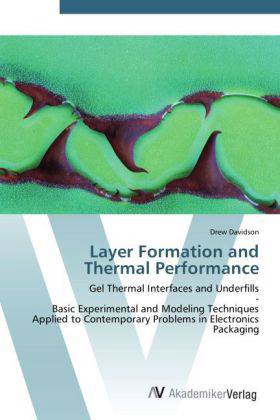
- Afhalen na 1 uur in een winkel met voorraad
- Gratis thuislevering in België vanaf € 30
- Ruim aanbod met 7 miljoen producten
- Afhalen na 1 uur in een winkel met voorraad
- Gratis thuislevering in België vanaf € 30
- Ruim aanbod met 7 miljoen producten
Zoeken
Layer Formation and Thermal Performance
Gel Thermal Interfaces and Underfills - Basic Experimental and Modeling Techniques Applied to Contemporary Problems in Electronics Packaging
Drew Davidson
Paperback | Engels
€ 86,22
+ 172 punten
Omschrijving
Revision with unchanged content. Better understanding of thermal interface materials is needed as today's electronic devices pack more power into less space. The first part of this work is an experimental and theoretical study of a gel thermal interface material with micron-sized alumina particles dispersed in a heat-curing silicone resin. Experimental and theoretical techniques are used to optimize the formation of thin layers by squeezing flow, and for relating layer thermal resistance to layer thickness. The feasibility is assessed of predicting layer thermal resistance as a function of the squeezing flow procedure, the measured bulk effective thermal conductivity, and the measured rheology. The advent of microfluidics is currently arousing greater interest in capillary flows at small length scales. The second part of this work is an experimental and theoretical study of the interface fingering observed in capillary flow of a Newtonian liquid in a corrugated Hele-Shaw cell (a simplified version of the underfill encapsulation of a flip chip device with trace lines). The relationship between interface finger length and channel geometry is explored.
Specificaties
Betrokkenen
- Auteur(s):
- Uitgeverij:
Inhoud
- Aantal bladzijden:
- 292
- Taal:
- Engels
Eigenschappen
- Productcode (EAN):
- 9783639437034
- Verschijningsdatum:
- 4/07/2012
- Uitvoering:
- Paperback
- Formaat:
- Trade paperback (VS)
- Afmetingen:
- 152 mm x 229 mm
- Gewicht:
- 430 g

Alleen bij Standaard Boekhandel
+ 172 punten op je klantenkaart van Standaard Boekhandel
Beoordelingen
We publiceren alleen reviews die voldoen aan de voorwaarden voor reviews. Bekijk onze voorwaarden voor reviews.








